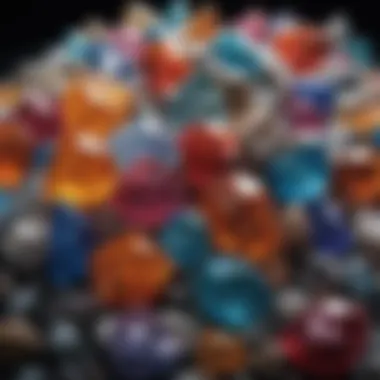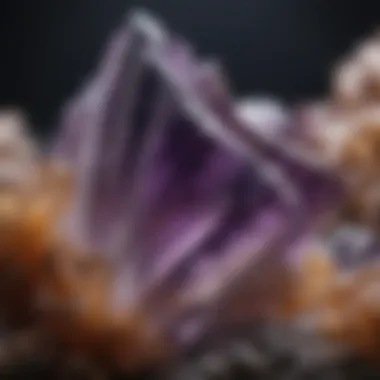Exploring the Beauty and Significance of Multi-Colored Crystals


Intro
Multi-colored crystals captivate the imagination of many, thanks to their stunning variety and unique properties. From the vibrant hues of amethysts to the subtle shades of opals, these natural wonders offer much more than visual appeal. This article delves into the multifaceted world of these crystals, aiming to inform collectors and enthusiasts alike.
Understanding multi-colored crystals involves examining their names, characteristics, and formation processes. These aspects not only contribute to their aesthetic charm but also influence their usage in various fields such as jewelry making, holistic practices, and industrial applications. This resource encourages a deeper appreciation for these crystals, highlighting their cultural significance and market trends.
The following sections will showcase a featured collectible, identification techniques, and insights on how to properly care for these remarkable stones. Each element seeks to enlighten the audience on the diverse and rich world of multi-colored crystals.
This exploration will bridge the gap between scientific knowledge and personal appreciation, forging a connection that enhances the experience of collectors.
Preamble to Multi-Colored Crystals
Multi-colored crystals captivate many with their vibrant hues and fascinating structures. They are more than mere decorative objects. Instead, they carry profound significance across various fields including geology, jewelry, and holistic practices. Understanding these crystals requires delving into their unique characteristics and formation processes.
Why Study Multi-Colored Crystals?
The exploration of multi-colored crystals opens doors to appreciate the complexity of nature's work. Each crystal type tells a story of geological processes and transformations occurring over eons. By studying them, collectors and enthusiasts can gain insights into earth sciences, mineralogy, and even our cultural heritage.
Furthermore, the appeal of crystals often extends beyond beauty. Many believe in their metaphysical properties, linking them to healing and spiritual practices. This blend of aesthetic and ethereal significance enhances their value, capturing the interest not just of collectors, but also of individuals seeking deeper meanings in their artifacts.
Benefits of Understanding Multi-Colored Crystals
Knowledge about multi-colored crystals offers several benefits:
- Appreciation of Diversity: Recognizing the different types and their attributes leads to a broader appreciation for the mineral world.
- Investment Insight: For collectors, understanding market trends and pricing factors can aid in making informed purchasing decisions.
- Cultural Significance: A grasp of how these crystals have been used throughout history in different civilizations enriches our understanding of human culture.
- Care Techniques: Knowing how to maintain these delicate treasures preserves their beauty and value over time.
Considerations in Collecting and Caring
Collecting multi-colored crystals demands knowledge about their specific characteristics and care. Factors like hardness, clarity, and risk of damage can impact what a collector should choose and how they should maintain their collection. An informed approach prevents costly mistakes and enhances the experience of collecting.
Classification of Multi-Colored Crystals
The classification of multi-colored crystals serves a pivotal role in understanding their variety and significance in various contexts. Community and collectors often rely on a systematic categorization of these crystals to appreciate their diverse attributes. By outlining specific traits, geologists and gemologists provide insight on how to evaluate and utilize these minerals. Additionally, this classification assists enthusiasts in identifying particular crystals based on visual cues and chemical composition.
Mineralogy Overview
Mineralogy provides the foundational knowledge necessary for classifying multi-colored crystals. This field studies the composition, structure, and properties of minerals. Each crystal exhibits unique mineralogical characteristics that inform its classification. For instance, elements like silica, aluminum, and iron contribute to the crystal's overall formation. The state of these elements within the crystal lattice can directly affect its color variations, clarity, and durability. Understanding mineralogy stabilizes the knowledge base from which collectors and jewelers operate, empowering them to make informed choices based on quality and value.
Color Variations Explained
Color variations in crystals arise from several factors, including impurities, the arrangement of atoms, and the presence of various elements. The interplay of chemistry and light leads to the unique appearance of each specimen. Often, the color can indicate the crystal's formation environment. For instance, the colors seen within a single crystal can point to differing geological conditions during its growth. Thus, identifying these colors is crucial for both appreciation and valuation in the crystal market.
Common Varieties and Their Names
Collecting multi-colored crystals involves recognizing and understanding prominent varieties. Four significant names often come up in discussions among rock and fossil collectors:
Fluorite
Fluorite stands out due to its rich array of colors, often displaying vibrant greens, purples, and blues. This mineral is notable for its fluorescence, making it appealing for collectors interested in unique visual traits. The clarity of fluorite can also be crystalline, with it forming cubes. It is a favorable choice due to its captivating colors and is often used in educational settings about mineralogy due to its distinctive optical properties.
Tourmaline
Tourmaline is recognized for its vast range of hues, changing even across a single crystal. The element boron within tourmaline contributes to this diversity, thereby enabling its classification into different species. The allure of tourmaline lies in its durability and multifaceted appeal, which makes it popular among jewelers. However, its formation can sometimes lead to inclusions that may affect its market value, hence understanding these features is vital for collectors.
Amethyst
Amethyst, a widely sought-after variety of quartz, is revered for its deep purple color. The presence of iron and natural radiation during growth contributes to this coloration. This mineral not only captivates collectors due to its stunning aesthetic but is also regarded for its historical significance in various cultures. Its value often fluctuates based on clarity, size, and the intensity of its hue, making it a crucial topic for those engaged in serious collecting.
Agate
Agate showcases layers of color and patterns, making each specimen unique. The banding seen in agate results from the deposition of silica in concentric layers. Due to its affordability and wide availability, agate is popular among both amateur and seasoned collectors. Despite being less costly than other gems, the distinctive patterns add significant value to each piece.
Formation Processes of Multi-Colored Crystals
The process by which multi-colored crystals form is a critical aspect of their study. It reveals much about the geological, chemical, and physical conditions necessary to create such intricate specimens. Understanding these processes not only helps collectors appreciate the aesthetic properties of their specimens, but also informs them about the rarity and value of these crystals in the market. It is essential to explore the geological conditions, the influence of impurities, and the gemological insights that collectively contribute to the formation of these captivating gems.
Geological Conditions for Formation
Multi-colored crystals require specific geological conditions to form. These processes typically occur in environments that allow significant mineral growth over time. For instance, the presence of extreme heat, pressure, and a range of chemicals can create the optimal conditions for crystal formation.
Some of the primary environments include:


- Igneous rocks: Formed from cooling magma, igneous rocks can give rise to multi-colored minerals as various elements crystallize at different temperatures.
- Metamorphic rocks: Heat and pressure transform existing rocks into new forms, resulting in the formation of multi-colored crystals under specific conditions.
- Sedimentary environments: Deposits of minerals can accumulate and form gems when subjected to heat and pressure, or by the evaporation of mineral-rich water.
The dynamic nature of Earth's geology ensures that conditions can vary greatly, leading to diverse colors and patterns in crystal formation.
Influence of Impurities
Impurities play a significant role in changing the color and overall appearance of crystals. While a pure crystal may exhibit a single color, minerals such as iron, manganese, or titanium can introduce new hues and variegations.
The presence of these impurities can affect:
- Color: Even small amounts of certain elements can dramatically alter a crystal's hue. For example, iron can impart green or yellow shades, while manganese can create pink or purple tones.
- Clarity: Impurities can often disrupt the internal structure of the crystal, affecting its clarity. This can lead to inclusions that may be prized by collectors for their uniqueness.
- Structural integrity: Some impurities may affect the overall strength and quality of the crystal. Understanding how these elements interact can help collectors assess the value and durability of their specimens.
Gemological Insights
Gems cannot be viewed merely as decorative objects; they tell a story of creation that spans eons. Gemology provides tools to understand the characteristics that define multi-colored crystals, examining aspects like refractive index, specific gravity, and crystal structure.
Through gemological study, collectors gain insight into:
- Identification: Expert analysis can identify the specific types of multi-colored crystals, which is fundamental for ensuring authenticity in a market filled with fakes.
- Value assessment: Understanding formation processes aids in recognizing the rarity and desirability of certain varieties, influencing their market price.
- Preservation techniques: Knowledge of how crystals form can inform collectors about appropriate care and display methods, allowing for longer-lasting investment in their collections.
Understanding these processes equips collectors with greater appreciation and informed decision-making when acquiring multi-colored crystals.
Properties of Multi-Colored Crystals
The properties of multi-colored crystals play a vital role in understanding their significance, both in aesthetic and functional contexts. For collectors and enthusiasts, these properties can influence decisions on purchase, display, and even appreciation of the crystals. Key characteristics such as hardness, clarity, and formation patterns shape the way these crystals are perceived and utilized, both in jewelry and various industries.
Physical Characteristics
Hardness
Hardness is one of the essential physical traits of a crystal. It is measured using the Mohs scale, which ranks minerals from one (very soft) to ten (extremely hard). This feature contributes significantly to the durability of multi-colored crystals. (For instance, diamonds score a perfect ten.) A higher hardness rating indicates how well a crystal can resist scratches or chips, making it a popular choice for various applications, especially in jewelry.
The unique feature of hardness lies in its application. Crystals like quartz, with a hardness of seven, are often sought after for their balance of beauty and practicality. They work well for daily wear items, blending appeal with resilience. However, this characteristic can be a double-edged sword; softer crystals, like calcite, may look stunning but should be used cautiously in jewelry, as they are prone to damage.
Clarity
Clarity refers to the transparency and purity of a crystal. It is an important factor that can determine a crystal's value and beauty. High clarity indicates a lack of inclusions or blemishes, allowing light to pass through more effectively. This quality enhances the visual appeal of multi-colored crystals, making them more desirable in both collector circles and commercial markets.
Notably, the clarity of crystals adds uniqueness to each specimen. For example, tourmaline often contains internal features that create a captivating optical effect, attracting those who appreciate crystalline diversity. Nevertheless, while high clarity is often seen as beneficial, some collectors may prefer stones with inclusions, as they can tell a more compelling story of the stone's natural journey.
Formation Patterns
Formation patterns provide insights into how a crystal evolved over geological time. These patterns can reveal a great deal about the environmental conditions under which the crystal formed. For instance, banding in agate suggests alternating conditions of temperature and pressure during crystallization, hence telling a rich geological story.
The unique aspect of formation patterns is their variability; no two crystals are identical, making each specimen special. This can enhance its appeal to collectors who place value on rarity and origin. However, certain patterns may also affect a crystal's price. For example, vividly patterned stones may command higher prices due to their striking appearance.
Chemical Properties
Crystal Structure
Crystal structure relates to how the atoms within a crystal are arranged. This aspect significantly influences various properties, including symmetry and stability. Many multi-colored crystals exhibit distinctive crystal structures which can affect light refraction, adding to their allure.
The key characteristic of crystal structure is that it determines how a crystal will grow and what kind of colors may appear in it. Varieties like fluorite often show cubic forms, which are visually striking. However, understanding a crystal's structure is also crucial for its usability in applications, since some arrangements yield greater stability than others.
Coloration Mechanisms
Coloration mechanisms are responsible for the captivating hues seen in multi-colored crystals. Various factors, including impurities, exposure to radiation, and inherent characteristics of the minerals, result in vibrant colors. These mechanisms can make a significant difference when evaluating a crystal's beauty and market value.
The unique feature of coloration mechanisms is their complexity. For example, the presence of transition metals can produce different colors depending on their oxidation states. This complexity adds depth to a crystal's narrative, attracting those interested in the science behind these natural wonders. On the downside, it can sometimes make identification and assessment more challenging for collectors not versed in gemology.
Uses of Multi-Colored Crystals
The usage of multi-colored crystals spans various fields, including industry and metaphysical practices. Each sector utilizes these beautiful minerals in unique ways, highlighting their versatility. Understanding how these crystals are applied enhances appreciation and informs potential collectors and enthusiasts about their significance.
Industrial Applications
Electronics
The electronics sector has a strong reliance on multi-colored crystals. Crystals like quartz are known for their piezoelectric properties, meaning they can generate electric charges when subjected to mechanical stress. This characteristic makes them essential in devices like watches and smartphones. The key characteristic of these crystals is their ability to resonate at precise frequencies, making them ideal for timing and frequency control. This reliability and performance of quartz in electronics underscore its value in contemporary technology.
Benefits:


- Precision: They ensure accurate timing essential for electronic devices.
- Durability: They withstand temperature variations, enhancing device longevity.
However, while the benefits are clear, sourcing high-quality crystals can be costly, impacting production sustainability and pricing.
Construction
In construction, crystals like granite and quartz are appreciated for their aesthetic appeal and durability. Multi-colored granite countertops, for instance, offer both style and resilience. The durability of these stones allows them to resist scratching and staining, which is a significant selling point in both residential and commercial constructions.
Benefits:
- Aesthetic Appeal: Varied colors attract buyers looking for unique designs.
- Long-lasting: They provide structural integrity while requiring minimal maintenance.
The primary drawback might be the expense involved in mining and processing, which can inflate project budgets.
Metaphysical Properties
Energy Healing
Energy healing is one of the most embraced uses for multi-colored crystals. Practitioners believe these stones can channel energies to promote healing and balance. For instance, amethyst is often associated with calming energy, while citrine is believed to boost self-esteem. Their application in alternative healing practices makes them popular among wellness enthusiasts.
Benefits:
- Holistic Approach: They offer a non-invasive way to support emotional and physical health.
- Variety: Different stones serve various healing purposes, appealing to a broad audience.
The skepticism surrounding such practices remains, as scientific backing is limited, but many users report personal benefits.
Spiritual Practices
Multi-colored crystals hold a significant place in spiritual practices across cultures. They are used in rituals, meditation, and as tools to focus intentions. For example, lapis lazuli is often used to enhance spiritual enlightenment. The key characteristic here is their symbolic meanings and spiritual vibrations that many believe can facilitate deeper connections with oneself or the universe.
Benefits:
- Focus and Clarity: They aid in meditation and mindfulness practices.
- Cultural Significance: Some stones carry historical importance, enriching practices with deeper context.
Critics might argue that reliance on physical objects for spiritual growth distracts from intrinsic development. Nevertheless, the presence of these crystals in spiritual settings continues to thrive.
Jewelry and Ornamental Use
Multi-colored crystals are widely celebrated in jewelry design. The variety of hues and patterns in stones like tourmaline or opal provides endless design possibilities. Not only do they serve as decorative pieces, but they also carry meanings and emotional significance for the wearers. Jewelry serves as a personal connection to the natural world and highlights individual taste and style.
Being not merely ornaments, these crystals can evoke memories and feelings attached to personal experiences or significant events.
Caring for Multi-Colored Crystals
Caring for multi-colored crystals is an essential aspect of maintaining their beauty and integrity. As mineral specimens, these crystals are often both visually striking and scientifically fascinating. Proper care ensures that their colors remain vibrant, their structures remain intact, and their value is preserved. For collectors and enthusiasts, understanding the best practices in cleaning, storing, and recognizing damage is vital.
Cleaning Techniques
Cleaning multi-colored crystals requires a gentle approach. Using harsh chemicals or abrasive materials can lead to scratches and degradation of the crystal's surface. Here are some recommended steps for effective cleaning:
- Soft Brush: Utilize a soft-bristled brush or an old toothbrush to remove any loose dirt.
- Warm Water: Soak the crystals in warm, soapy water. A mild dish soap works well.
- Rinse Thoroughly: After soaking, rinse thoroughly under cool running water to ensure all soap residue is removed.
- Drying: Pat them dry with a soft cloth. Avoid using paper towels, as they can scratch the surface.
Storage Recommendations
Proper storage is crucial for preserving the condition of multi-colored crystals. Consider the following storage tips:
- Separate Compartment: Store each crystal in its own compartment or jewelry box. This prevents scratches between pieces.
- Use Soft Pouches or Wraps: Placing crystals in soft pouches or wrapping them in microfiber cloth protects them against dust and impact.
- Avoid Direct Sunlight: Prolonged exposure to sunlight may fade the colors of some crystals, so store them in a cool, dark place.
- Humidity Control: Maintain a stable humidity level to avoid moisture damage. Consider silica gel packs in storage areas.
Recognizing Damage and Wear
Monitoring the condition of multi-colored crystals is essential for collectors. Recognizing signs of damage helps in maintaining their value:
- Visual Inspection: Regularly inspect the crystals for chips, cracks, or cloudiness. These can indicate wear and may affect their aesthetic and market value.
- Tactile Examination: Run your fingers over the surface to feel for rough spots or irregularities that may not be visible.
- Color Changes: Any fading or alteration in color can suggest damage, particularly from exposure to sunlight or chemicals.
Important Insight:
Taking the time to care for your multi-colored crystals not only enhances their appearance but also preserves their historical and monetary value for future generations of collectors.
In summary, employing proper cleaning techniques, storing crystals thoughtfully, and knowing how to detect damage are fundamental practices for anyone engaged in the world of multi-colored crystals. This diligence helps ensure that each piece continues to be a cherished part of a collection.
Market Trends for Multi-Colored Crystals
Understanding market trends for multi-colored crystals is essential for collectors and enthusiasts. The market is influenced by various factors, including availability, demand, and cultural relevance. These elements can significantly impact both the value of crystals and the strategies used for collecting. Additionally, as global interest in crystals grows, so does the need for informed decision-making. Collectors must recognize these trends to navigate the complex landscape of crystal collecting successfully.


Collecting Strategies
When it comes to collecting multi-colored crystals, having a strategic approach is key. A well-thought-out strategy allows individuals to expand their collection effectively while avoiding pitfalls. Here are some strategies for collectors:
- Research: Understanding the properties and origins of particular crystals can enhance your collection. Reading books, joining forums, and following reputable online sources will illuminate important trends.
- Networking: Connect with other collectors through social media platforms or local clubs. Engaging with experienced collectors can provide insights into your chosen crystals and potential market developments.
- Focus Areas: Identify areas of specific interest. This could be specific types of crystals, geographical origins, or historical significance. Specialization may lead to more rewarding collecting experiences.
- Trade Shows and Exhibitions: Attend events to meet vendors and other collectors. This can add value to your collection by providing rare acquisition opportunities.
These strategies can help collectors cultivate a meaningful and valuable collection while also keeping them informed about evolving market conditions.
Pricing Factors
The pricing of multi-colored crystals can vary widely due to several factors. Understanding what drives these prices is crucial for collectors who want to make wise investments. Key pricing elements include:
- Rarity: Crystals that are hard to find in nature generally command higher prices. For example, some varieties of Tourmaline are more valuable than others due to their unique color variations.
- Quality Indicators: Factors like clarity, size, and luster directly influence how much collectors will pay. Crystals with fewer inclusions and better coloration tend to be more sought after.
- Market Demand: Fluctuations in the popularity of certain minerals will affect pricing trends. Keeping an eye on the marketplaces may help collectors anticipate price changes.
- Cultural Significance: Crystals that have historical importance or are associated with particular cultural practices often see higher valuations.
A well-informed collector can leverage these factors to optimize their spending and enhance their collection's overall value.
Fakes and Replicas
As with any collectible market, the existence of fakes and replicas in the crystal world persists. This can be a major concern for collectors striving to build a genuine collection. Important points to consider include:
- Identification: Learn how to distinguish authentic crystals from replicas. Researching the specific characteristics of your targeted crystals can help you verify authenticity.
- Reputable Sellers: Always purchase from established and reputable dealers. Check for certifications or third-party appraisals when applicable.
- Community Feedback: Leverage online platforms, like Reddit or specialized Facebook groups, to gain insights and share experiences regarding potential scams.
- Documentation: When investing in high-value crystals, ensure that you receive documentation that verifies the crystal's authenticity and quality.
By being aware of potential fakes and employing careful purchasing practices, collectors can safeguard their investments and build a reputable collection.
Cultural Significance of Multi-Colored Crystals
Multi-colored crystals hold a profound place in various cultures and traditions. Their beauty and diversity not only captivate collectors, but also serve deeper meanings historically and presently. Understanding the cultural significance of these crystals unveils their roles as symbols, tools, and sources of inspiration.
Historical Uses in Civilizations
Throughout history, different civilizations have imbued multi-colored crystals with meaning and value. For instance, ancient Egyptians utilized lapis lazuli, renowned for its deep blue hue with golden flecks. It was believed to provide protection and clarity of thought. Additionally, the Mayans carefully crafted jade into ornaments, seeing its green coloration as a representation of life and fertility.
The Greeks prized amethyst for its rich purple color, associating it with sobriety and stability. In their culture, it was thought to prevent intoxication and was widely used in jewelry. Similarly, Romans held a fondness for garnets; these stones were often set in elaborate designs, showing not only wealth but also connection to the divine.
These usages highlight how crystals have served as more than mere decorative items. They were integral to spiritual beliefs and daily life, further embedding multi-colored crystals in the collective consciousness.
Modern Cultural Connections
In contemporary times, the fascination with multi-colored crystals continues to thrive. Many enthusiasts integrate these stones into various aspects of their lives. For example, practitioners in the New Age movement often utilize crystals for their purported healing properties. Crystals like rose quartz and citrine are popular choices for promoting love and prosperity, respectively.
Collectively, people use multi-colored crystals to enhance mindfulness and meditation practices. Possessing a crystal may provide a sense of comfort, connection to nature, and emotional grounding.
Furthermore, social media platforms like Instagram and Pinterest have spurred interest in crystal collecting. Aesthetic photos highlight their vibrant colors and unique forms, attracting a broader audience.
"Multi-colored crystals are not merely objects of beauty; they are vessels of history, culture, and personal story."
Understanding this cultural significance fosters greater appreciation among collectors and enthusiasts, enriching their experience as they engage with these remarkable treasures.
End and Future Perspectives
The exploration of multi-colored crystals serves not only to inform collectors and enthusiasts but also to foster a greater appreciation for their complex beauty and uniqueness. As we conclude this article, several important points in relation to the future of multi-colored crystal collection and understanding emerge.
Understanding the trends within the collectible market indicates how interests shift over time. Collectors must be aware of these trends as they can significantly impact the value of their collections. Moreover, knowing which types of crystals are gaining popularity can guide purchasing decisions and potentially enhance the value of investments.
"Emerging trends often reflect broader cultural movements and preferences among collectors."
Technological advancements also present exciting prospects for the research and collection of multi-colored crystals. The integration of new technologies can improve both the way we identify and authenticate various specimens. For example, advancements in spectroscopy and imaging techniques enhance our ability to analyze the crystal structure and composition effectively.
On a broader scale, sustainability and ethical sourcing are becoming increasingly relevant in the crystal market. Collectors are increasingly interested in understanding the origins of their specimens and ensuring they are sourced responsibly. This is a vital consideration going forward as it can influence collector values and priorities.
Emerging Trends in Collecting
As the world evolves, so too do interests in collecting crystals and gemstones. A notable trend includes a growing fascination with environmentally friendly and ethically sourced crystals. Collectors today are more aware of where and how these crystals are obtained. This shift is not merely about aesthetics but also reflects a broader ethical standpoint.
Another trend includes a rising interest in lesser-known varieties of crystals. Instead of focusing solely on popular options like Amethyst or Tourmaline, collectors are exploring unique specimens that provide a fresh perspective to their collection. This shift encourages a more diverse understanding of geological variations.
To maximize their collection strategy, knowledgeable collectors often:
- Conduct thorough research on emerging varieties.
- Network with other collectors to share insights about new trends.
- Monitor auctions and market platforms to discover items before they become mainstream.
The Role of Technology in Research and Collection
Technology has a profound impact on how collectors approach multi-colored crystals. Identification and authentication processes have become significantly more accurate with modern tools. Techniques such as X-ray diffraction and infrared spectrometry provide detailed information about a crystal's properties, ensuring that each piece is genuine.
Furthermore, online platforms serve a vital role in fostering community among collectors. Websites like Reddit and Facebook host dedicated groups where individuals can share experiences, discuss findings, and exchange knowledge about various crystals.
Additionally, apps and digital tools for inventory management and documentation of collections have become increasingly popular. This allows collectors to maintain organized records of their specimens with ease, contributing to an overall better understanding of their collections.



